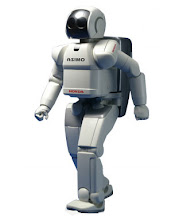P.W. Singer, Senior Fellow at the Brookings Institution and author of the new book Wired for War: The Robotics Revolution and Conflict in the 21st Century. Served as coordinator of the Obama campaign’s defense policy task force. He is also the author of Corporate Warriors and Children at War.
For those who won't bother to follow the link, it is basically about the use of robots in war, primarily by the US in Iraq and Afghanistan. I subscribe to some delicious RSS feeds on robotics/robots as well as feeds from Google News. So each day some of this kind of stuff pops up in my news reader (does reading these online feeds take me further into or further out of the field?). But I hadn't really read that much about war robotics and so on (just scanned the titles), as this is mostly an American thing and not the central aspect of my research.
It's come up a bit though. People have told me: go to the US and you can get a lot of DARPA money to build war robots. It is not like that in Japan though. As far as I can tell, and as far as I would imagine, there is minimal military robotics in Japan. I suppose this kind of thing would be against the pacifist constitution and post-Hiroshima/Nagasaki mentality. Indeed, most people (while a bit envious of all that funding money) seem to have narrowed eyes and tight faces when discussing US warbots. I've been told by one person that the word 'robotics' sounds like military robotics and so he prefers the term 'social robots'. An American working here told me that he looked for some robotics jobs in the US but it was all building kill machines which he thought was antithetical to the years he had spent in the peace corps. Then he came here and saw a robot hug someone, and decided that's what I want to do!
Anyway, so I learned a bunch about war robotics from this interview, very interesting, I can see why there is the constant chatter about ethics and "real life Terminator" in my RSS feeds.
Like this:
When US forces went into Iraq in 2003, they had zero robotic units on the ground. Now they have as many as 12,000.And this vivid image:
P.W. SINGER: Yeah, when I use the term "robotics revolution,” I need to be clear here. You know, I’m not talking about a revolution where, you know, your Roomba vacuum cleaner is going to sneak up and ambush you. We’re talking about a revolution in the way wars are fought and who fights them. And this aspect of distance is one of the big ones. It changes the very meaning of going to war.
You know, my grandfather served in the Pacific fleet in World War II. When he went to war, he went to a place where danger took place, and the family didn’t know if he was ever coming back. And that’s very different than the experience of, for example, a Predator drone pilot that I met with who described that basically his experience of fighting in the Iraq war was getting in his Toyota Corolla, driving to work—he’s doing this in Nevada—driving into work, for twelve hours he puts missiles on targets, then gets back in the Toyota, commutes back home, and within twenty minutes he’s talking to his son at the dinner table.
AMY GOODMAN: When you say “puts missiles on targets,” you mean bombs.
P.W. SINGER: Hellfire missiles. You know, he’s basically—he is engaging—
AMY GOODMAN: He attacks, I mean.
P.W. SINGER: He is engaging in combat. But he’s doing it from 7,000 miles away. And then, at the end of the day, he goes to a PTA meeting or takes his kid to soccer practice. And so, it’s a whole new experience of war, which is actually creating a new concept of a warrior.
Hrmm... Military Industrial Complex indeed... I really want to read his book. In fact, all three might be very interesting; he has written on mercenaries, child soldiers, and war robots. Interesting topics for anthropology. Can't you just see the list of research interests (all capitals of course): Personhood, Slavery, and Things; Capitalism and War; Modernity and 'Risk'




No comments:
Post a Comment